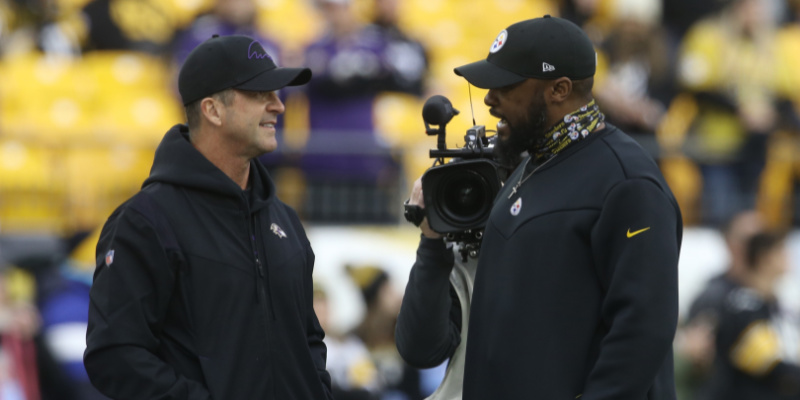Analysis
12/7/21
7 min read
The Urgency Meter: Analyzing 4th Down Decisions from Week 13

Week 13 provided us with many more excellent opportunities to try and understand the logic behind the decision making process on 4th down. The league is trending towards every team giving serious consideration to 4th down decisions.
The Eagles went for it on 4th down three times in one drive with Minshew Mania at the helm. The Bears attempted a 4th down with eight yards to go with their backup quarterback Andy Dalton in the second quarter. The Seahawks even scored a touchdown by going for it, albeit on a fake punt.
Let’s take a deep dive on three of the biggest decisions made during Week 13.
Detroit Lions vs Minnesota Vikings
With the Lions searching for their first victory on the season, they entered the final four minutes and eight seconds of the game with a two point lead. Their drive appeared to stall on third down at their own 28 yard line with one yard to go.
Conventional thinking here would suggest punting the ball and relying on your defense to get a stop and close the game out as the Vikings are within field goal position already should the 4th down attempt fail.
One could also argue that with not much to lose on the season at this point, why not go for it and be aggressive.
The reason to not go for it and be aggressive would be if it gives you a worse probability of winning the game. This would not be aggressive, it would be reckless.
So what do the numbers say?
When we input the current situation into The Urgency Meter, we got the following:
-
- Probability of First Down: 0.48
- FG Distance: 89
- Average Expected Points from Drive: 1.16
- Average Expected Points if Kick: 0.03
- Average Expected Points for Opposition on Current Drive: 2.44
- Average Expected Differential: 0.72
- Average Expected Points Rest of Game Home: 1.79
- Average Expected Points Rest of Game Opposition: 1.78
Urgency Meter Score: 0.48
With an Urgency Score of 0.48 the model is suggesting not to go for it and instead to punt it. The oppositions' average expected points on that specific drive stands at 2.44 which is significantly above the Lion’s at 1.16. In this specific drive, it is in the Viking’s best interest to have the Lions go for it.
However, the Urgency Meter takes into account all of the predicted remaining possessions and their average expected points in its decision making process. With an Average Expected Differential of 0.72, the model predicts that the Lions will win by 1 point which has an impact on the final suggestion being to punt.
It is worth pointing out however that an Urgency Meter score of 0.48 is extremely close to the threshold of 0.5 which is the cutoff point for the model between suggesting to go for it or not.
Although the model suggests to pun in this situation, it is not far away from agreeing with the Lions decision.
What Actually Happened?
Goff was strip sacked, providing the Vikings excellent field position to go and close the game out. They scored a touchdown with 1:51 remaining, which was also a contentious decision as it gave the Lions the ball back with a chance to win. The Lions then won the game on another 4th down play with only four seconds to go, throwing for a touchdown to win by two points.
Seattle Seahawks vs San Francisco 49ers
Seattle played host to one of the wildest games of the season on Sunday evening with a lot of mistake-prone football paving the way for a highly entertaining NFC West showdown.
With the Seahawks already scoring a touchdown from a 4th down situation, the match was nicely poised with 6:20 to go. The Seahawks had a seven point lead when Pete Carroll had an interesting decision to make. With only one yard to go to get a first down and less than four yards to go to the 49ers end zone, should he take the chip shot field goal to extend the lead to ten points or play for the first down?
The model suggested the following:
- Probability of First Down: 0.48
- FG Distance: 21
- Average Expected Points from Drive: 2.55
- Average Expected Points if Kick: 2.87
- Average Expected Points for Opposition on Current Drive: 0.97
- Average Expected Differential: 7.1
- Average Expected Points Rest of Game Home: 2.21
- Average Expected Points Rest of Game Opposition: 3.68
Urgency Meter Score: 0.33
With an Urgency Meter Score of 0.33, the model is suggesting to take the field goal and not to go for it on 4th down, contrary to what the Seahawks did.
The model has the average expected points for the kick to be extremely close to 3 points, indicating that there is only a very small chance that the kicker misses. The model also only predicted the 49ers on average only to score just under four points for the rest of the game. With a successful field goal, the 10 point lead versus the 49ers 3.68 expected points lead to the model believing that there is no urgency to risk the win for a killer punch. The Seahawks should have in fact taken the field goal.
What Actually Happened?
The Seahawks secured the first down before turning the ball over at the 1 yard line to San Francisco. San Francisco then drove the length of the field before failing their own 4th down attempt with a chance to tie the game. The Seahawks did in fact win the game by seven points, as the model predicted.
Baltimore Ravens vs Pittsburgh Steelers
The Ravens might be the team best suited in the league to argue that they should not be included in any model that uses past data to predict the future as they contain two vital players for 4th downs that are true anomalies. Lamar Jackson and Justin Tucker totally defy the “average” at their position, leading to John Harbaugh having a strong chance of success regardless of the decision he makes.
With the game seemingly poised to go to overtime assuming Tucker makes the extra point, Harbaugh decided in fact to go for two points to win the game outright. While not quite a 4th down decision, the Urgency Meter can still be applied here to determine if the Ravens had a greater probability of winning the game in that moment or in fact by taking the field goal and hoping to win it in overtime.
Based on previously similar decisions from the 2018 season onwards the model suggested that the probability of getting the two-point conversion and hence winning the game was 41%.
With regards overtime, the general consensus of a tied game is that the probability of winning is close to 50/50. Attempting to get a bit more specific, most teams elect to receive the ball should they win the toss so the probability of winning the game in overtime would require winning the toss and scoring a touchdown or scoring a field goal and then proceeding to make a stop. The reverse would apply should they lose the coin toss. When running the model for the rest of overtime, the Ravens were expected to win by three points, suggesting that the Ravens were incorrect to go for it with the two point conversion, as the model recognizes them as the better team.
As a general consensus, the model appears to indicate that if you’re the better team, you should want as many possessions and plays as possible. Anything can happen on one play with the small sample size. But the more plays, the more likely it is that better quality teams rise to the top.
What the model does not take in to account is what John Harbaugh alluded to in his post game press conference whereby the Ravens were decimated with injuries and certain in game situations can make past data redundant and this may have been one of these decisions.
A general rule of thumb is the weaker team should take their opportunity to win the game when they get it. Maybe Harbaugh believed in that specific moment, the Ravens were in fact a weaker team with their injuries, and so perhaps he did indeed make the correct call?








